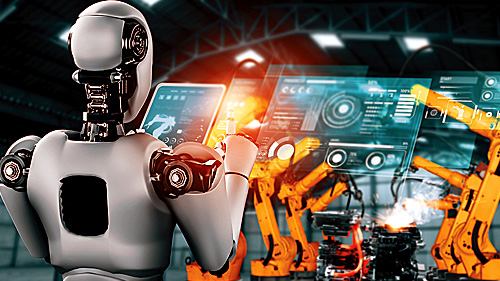Taking Action Now for An Increasingly Automated Future
The jobs created by automation will ultimately exceed those that are lost, but a federal program is needed to successfully navigate the transformation of the labor force.
Q2 2022

Many people have an adverse reaction to discussions of automation and artificial intelligence. While I understand those fears, I believe we need to embrace automation. In fact, let’s put our foot on the gas — or set the autonomous electric vehicle at max speed. But as we accelerate toward automation, we must reposition our workforce for a successful journey.
Whatever the outcome, the Tesla Bot is simply the continuation of a process that began decades ago to create ever more sophisticated forms of automation. The pandemic only quickened this movement as companies turned to automation out of necessity (currently 500,000 manufacturing job openings are unfilled) and for strategic reasons (automation can be very attractive financially, especially in the current period of exploding demand).
Navigating the Transformation
While some taxation and public policy proposals aim at stopping or slowing the adoption of automation, myriad studies show such measures would be detrimental to the economy. The global economy is expected to struggle in the coming decade to keep up with demand driven by the baby-boom generation entering retirement, while still creating significant demand for goods and services combined with declining global birth rates — 2020 was the lowest rate on record in the U.S.
Some fears are not unfounded. People worry automation would create mass unemployment. One report estimates 36 million U.S. workers could face job losses due to automation. Most experts agree much of this change will occur in the next decade. However, these experts also agree that the global economy will be able to navigate this transformation.
A 2020 MIT Task Force on the Work of the Future report projected, “In the next two decades, industrialized countries will have more job openings than workers to fill them.” It further states, “History and economics show no intrinsic conflict among technological change, full employment, and rising earnings.”
The review of significant work on this topic makes me optimistic about an automated future. I say, bring on the robots. I believe automation is an integral part of a growing global economy, and it has the potential to significantly improve the quality of life for millions of workers over the next decade. I also readily admit that this is going to be really hard.
As we accelerate toward automation, we must reposition our workforce for a successful journey. Much of the research on this topic suggests we can predict a labor transition en masse rather than mass unemployment. In other words, automation will surely eliminate the need for millions of jobs, but job creation across the economy will exceed those losses. Globally, tens of millions of workers will need to switch occupational categories and learn new skills in the coming decade. And it is this transition of workers — not technology, robots or fear — that deserves our attention.
Major labor disruptions conjure up visuals that are hard to ignore: thousands of workers leaving the production line for the last time, white-collar workers exiting an office building with their belongings in a box. These events are location-based and easy for media to cover — and difficult for public officials and government agencies to ignore. The displacement of millions of workers due to automation will likely occur each year with little publicity. The mass will be in the combined impact on individuals rather than the closure of any single facility.
The speed and sweeping nature at which workers will be forced to transition will create unique demands on the public systems supporting those affected. The labor force must be able to adapt as swiftly as the automation takeover. Slow or failed transitions are the prime threat to the economy during this period, which can lead to high unemployment and depressed earnings and demand.
The Need for Government to Step Up to the Challenge
Make no mistake: The robots are coming. Some of them are already here. Every day without action to retrain affected workers is a day the U.S. is falling behind. The federal government needs to create and implement an infrastructure to manage labor during the next two decades of change. Recent bills have been filed in the U.S. Senate (2019 and 2018) but have gone nowhere. These bills sought to expand the federal Trade Adjustment Assistance (TAA) program, which played a major role in supporting workers who were displaced by NAFTA.
Automation has the potential to significantly improve the quality of life for millions of workers over the next decade. A federal program is required to mount the massive effort needed to support workers during this reorganization of the global economy. Experts agree that modern systems and institutions are not up to the task. The pace of automation’s disruption to the labor market is expected to be two to three times that of previous periods of technological advancement. In addition, the automation of tasks will occur across geographies, industries (goods production, services, and everything in between) and occupations (white-collar and blue-collar, hourly and salary). This transition will be worldwide, but no country is prepared. In fact, most countries in the Organization for Economic Co-operation and Development have been spending less on worker training and labor market transitions during the past 20 years. In the U.S., public spending in these two categories has not only declined but ranks at or near rock bottom.
The federal government needs to create and implement an infrastructure to manage labor during the next two decades of change. I recommend the federal government act immediately to meet this challenge. Modifying TAA or developing a new system is bound to be a lengthy and difficult road. I suggest the federal government create and fund a system that will partner with states and regions to accomplish one very narrow goal: transition affected workers into new, permanent positions with maximum speed. This will take significant federal investment. However, failure to address this effectively will likely lead to a crippled economy.
While this transition demands a federal response, nothing stands in the way of states, regions, and cities taking independent action. Leading successfully in this area will pay huge dividends as local labor markets position themselves for the future. Those leading states and communities will also be in position to maximize their impact once federal dollars and programs flow to address these needs.
Collectively, we need to change the narrative on automation. This imminent shift represents great opportunity. It will require the best of American ingenuity and demand flexibility from each of us to learn new things and pursue new frontiers. Government must create a new infrastructure to manage this transition, companies must invest in their employees, and individuals must invest in their skills to adapt to a new world. As technology accelerates, so must we. The time to act is now.
Project Announcements
Lattice Materials Expands Bozeman, Montana, Manufacturing Operations
01/14/2026
xAI Plans Southaven, Mississippi, Data Center Operations
01/14/2026
Canada-Based GreenPower Plans Santa Teresa, New Mexico, Headquarters Operations
01/14/2026
Integrated Rail and Resources Plans Uintah County, Utah, Operations
01/13/2026
MCM Engineering II Expands Enoch, Utah, Operations
01/12/2026
Lithium Battery Company Plans Tampa, Florida, Battery Pack Production Operations
01/10/2026
Most Read
-
The Workforce Bottleneck in America’s Manufacturing Revival
Q4 2025
-
Data Centers in 2025: When Power Became the Gatekeeper
Q4 2025
-
Speed Built In—The Real Differentiator for 2026 Site Selection Projects
Q1 2026
-
Preparing for the Next USMCA Shake-Up
Q4 2025
-
Tariff Shockwaves Hit the Industrial Sector
Q4 2025
-
Investors Seek Shelter in Food-Focused Real Estate
Q3 2025
-
Strategic Industries at the Crossroads: Defense, Aerospace, and Maritime Enter 2026
Q1 2026



